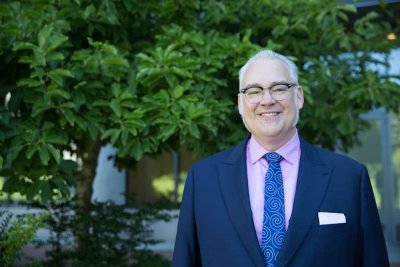Tuesday Q&A: Inside the media framing of Muslim candidates in the 2018 midterms
WWU Associate Professor of Journalism Brian J. Bowe, along with colleagues Lawrence Pintak of Washington State University and Jonathan Albright of Columbia University, recently received funding from the Association for Education in Journalism and Mass Communication's Senior Scholars Program on a research proposal titled “Mediatization of Islamophobia in the 2018 Election.”
Bowe said their research will focus in interviewing candidates to explore how they were covered by the media during the election and how Islamophobia may have played a part in that coverage. Bowe is also the co-author, along with WWU's Joe Gosen and the University of Arizona's Shahira Fahmy, of "Personal Choice or Political Provocation: Examining the Visual Framing and Stereotyping of the Burkini Debate," just published in the Journalism & Mass Communications Quarterly.
Western Today reached out to Bowe, who is currently on a Fulbright at the University of Jordan’s American Studies program in Amman, to chat with him about his research and look a little deeper into what he hopes to find.
WT: Brian, your research is focused on how the media covered Muslim candidates in the 2018 elections and the role of Islamophobia in both that coverage and in their campaigns in general. What were a few of the broad takeaways from the way they viewed the coverage of their campaigns?
Our work is still very preliminary, but a couple of overarching themes are beginning to emerge. The first is that Muslim women candidates’ experiences are much different than those of Muslim men. Many women candidates were forced to confront the compounded effects of Islamophobia, sexism, and often racism as well. As such, they report being subjected to verbal and physical threats at more than twice the rate of their male counterparts.
Another overarching theme is the problematic role media coverage played. Candidates overwhelmingly identified media coverage as unfair. They said it spreads fear of Muslims by presenting Islam as a threat to U.S. culture.
One of our next steps is to closely examine the media framing in these elections to unpack what about the coverage was troublesome. My previous research has repeatedly shown that mainstream media coverage is not usually overtly Islamophobic, but that even purportedly neutral or benign coverage frequently contains deeply embedded tropes that present Muslims as outsiders. It will be interesting to see how these dynamics play out here.
WT: According to monitoring groups like the Southern Poverty Law Center, there has been a huge spike in the number of hate groups since the 2016 presidential election. What kind of impact did these groups have on these candidates specifically and on the media landscape in general in 2018?
It is undeniable that there has been a troubling spike in anti-Muslim sentiment in the U.S. over the last couple of years. Too often, this sentiment spills over into vandalism and violence. One of the interesting outcomes of this situation it has energized Muslim-Americans to become politically active in ways they have not previously. There is a strong sense of wanting to be an active part of the solution. Not only are these candidates taking an active role in opposing policies they find unjust, they are also actively challenging the media narratives about Muslims in America.
WT: On one hand, there are more women and people of color in the U.S. House of Representatives than ever before after the 2018 midterms, and the first two Muslim women ever elected, Ilhan Omar and Rashida Tlaib, are now seated members of Congress. On the other hand, a newspaper editor in Alabama recently called for the return of the KKK to “ride again.” Based on your interviews with 2018 candidates, do you think this type of polarity will result in more or fewer Muslim candidates in the future?
It’s hard to know the future, but vitality of these candidates seems to signal a lasting change. The fact that the Bernie Sanders’ campaign hired Faiz Shakir as campaign chair — the first Muslim to run a major presidential campaign — is one important indicator that 2018 was not an aberration.
WT: Does social media play a broader role in the framing of Muslim candidates in the media than it does for other candidates?
This is data that we are still analyzing, but it seems like that is only true in some cases. In particular, Rep. Omar had an enormous amount of social media engagement. As a young, hijab-wearing refugee woman of color in a high-profile race, she was a lightning rod for social media traffic both in an out of her district. This, of course, has continued now that she is in office.
WT: How have these candidates been able to counter the attacks on them because of their religious views, if at all?
When we asked this question, the dominant strategy we found that candidates simply ignored them. It seemed that they choose not to give oxygen to those kinds of attacks. We hope to learn more specifics about their strategies in our upcoming interviews with candidates.
Brian J. Bowe received his doctorate in Journalism from Michigan State University in 2013 and has taught at Western since 2015. His research focuses on framing, media coverage of Islam, and journalism pedagogy and curriculum design. He has written several books about popular music, including biographies of The Ramones, The Clash, and Judas Priest. He coedited the anthology CREEM: America’s Only Rock ’N’ Roll Magazine (2007, Collins).
